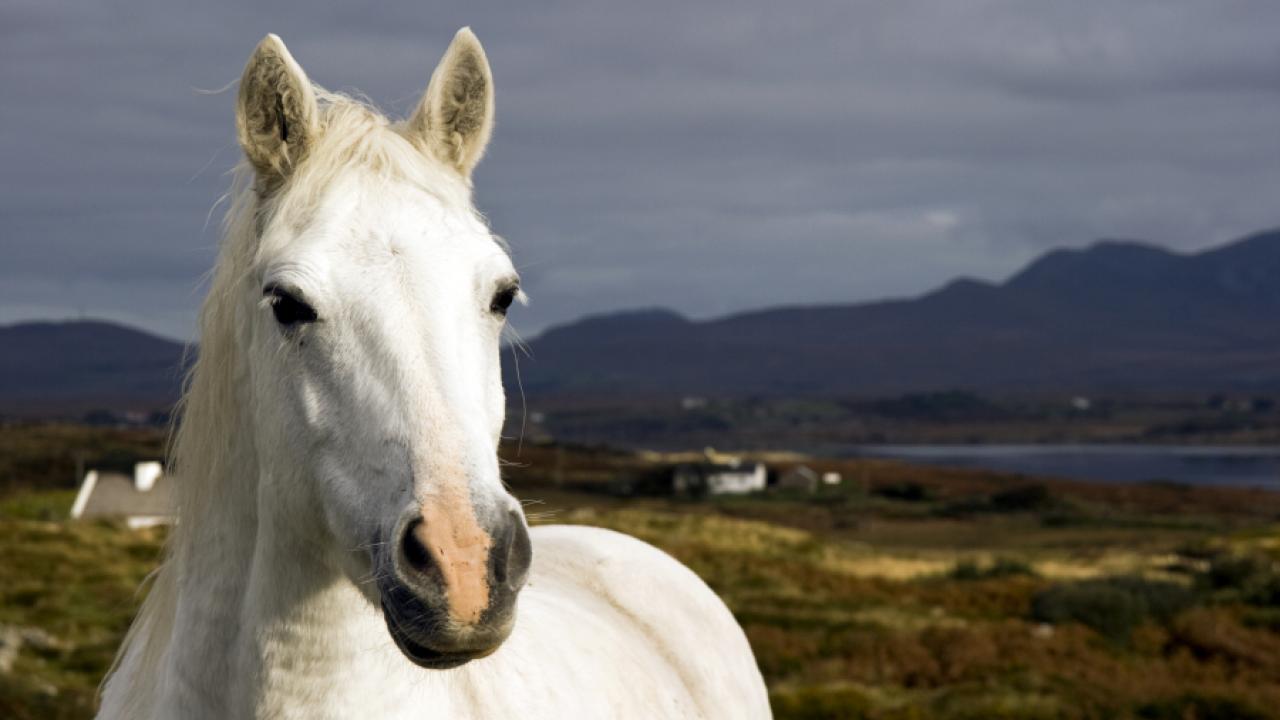
Eye Cancer Risk Factor Found in Three Additional Horse Breeds
Background: A growing body of research has identified and characterized a genetic risk factor for ocular squamous cell carcinoma in three breeds of horse: the Belgian, Haflinger, and Rocky Mountain Horse. Ocular squamous cell carcinoma (SCC) is the most common cancer of the equine eye, and its occurrence in the three breeds listed above has been linked to a genetic variant in the UV damage DNA repair gene Damage-specific DNA Binding Protein 2 (DDB2). Recent research has provided evidence that the variant, a missense mutation that changes the 338th amino acid of the gene’s protein product from threonine to methionine, produces a protein that is unable to detect and thus repair DNA damaged by sunlight.
Though the DDB2 variant has been linked to SCC risk in the Belgian, Haflinger, and Rocky Mountain Horse, studies of SCC-affected Appaloosas and Arabians found no link between presence of the variant and SCC in those breeds. The link between the DDB2 variant and SCC in other breeds is still under investigation.
The research: A new study by UC Davis Veterinary Genetics Lab researchers, in conjunction with Dr. Launois in France and Drs. Fleming and McCoy at the University of Illinois, evaluated three clinical cases of SCC in additional breeds (two cases in Connemara Ponies and one in a Holsteiner-Belgian Warmblood cross). The scientists genotyped each affected individual for the DDB2 genetic risk factor and calculated allele and carrier frequencies for each breed by genotyping subsets of banked DNA samples.
The results: All three SCC cases genotyped homozygous (T/T) for the DDB2 c.1013 C>T risk variant (reported by the VGL as R/R, where R stands for risk). Out of 86 Connemara Ponies in the larger sample population, 6 were homozygous for the risk allele and 25 were heterozygous; carrier frequency was 0.29 (that is, approximately 3 ponies in 10 had one copy of the risk variant). Of 115 Holsteiners in the sample set, none were found to be homozygous for the risk variant and only one was horse genotyped heterozygous (C/T); carrier frequency suggests that 9 Holsteiner horses in 1000 will have one copy of the risk allele. Out of 76 Belgian Warmbloods in the sample set, none were homozygous for the DDB2 risk variant, and two horses were found to be heterozygous; carrier frequency was 0.028 (approximately 3 horses in 100). Taken together, these data support the use of this genetic test in these additional breeds, particular in the Connemara Pony, where the moderate allele frequency (0.22) is similar to that reported for Haflinger and Belgian horses, in which many cases have now been investigated.
For more on this study see: https://www.mdpi.com/2073-4425/11/12/1460
The results of this study support the expanded use of the ocular SCC test in Connemara Ponies, Holsteiners, and Belgian Warmbloods to identify at-risk individuals and to assist in breeding decisions.
Funding and acknowledgments:
This work was supported by
- UC Davis Veterinary Genetic Laboratory
- The UC Davis Center for Equine Health with funds provided by the State of California satellite wagering fund and contributions by private donors
References:
Lassaline, M., Cranford, T. L., Latimer, C. A., & Bellone, R. (2015). Limbal squamous cell carcinoma in Haflinger horses. Veterinary Ophthalmology, 18(5), 404-408. doi: 10.1111/vop.12229
Bellone, R. R., Liu, J., Petersen, J. L., Mack, M., Singer-Berk, M., Drögemüller, C., Malvick, J., Wallner, B., Brem, G., Penedo, M. C., & Lassaline, M. (2017). A Missense Mutation in Damage-specific DNA Binding Protein 2 Is a Genetic Risk Factor for Limbal Squamous Cell Carcinoma in Horses. International Journal of Cancer, 141(2), 342-353. doi: 10.1002/ijc.30744
Singer‐Berk, M., Knickelbein, K. E., Vig, S., Liu, J., Bentley, E., Nunnery, C., Reilly, C., Dwyer, A., Drögemüller, C., Unger, L., Gerber, V., Lassaline, M., & Bellone, R.R. (2018). Genetic risk for squamous cell carcinoma of the nictitating membrane parallels that of the limbus in Haflinger horses. Animal Genetics, 49(5), 457-460. doi: 10.1111/age.12695
Knickelbein, K. E., Lassaline, M. E., & Bellone, R. R. (2018). Limbal squamous cell carcinoma in a Rocky Mountain Horse: Case report and investigation of genetic contribution. Veterinary Ophthalmology, 22(2), 1–5. doi: 10.1111/vop.12612
Knickelbein, K. E., Lassaline, M. E., Singer‐Berk, M., Reilly, C. M., Clode, A. B., Famula, T. R., Michau T.M., & Bellone, R. R. (2019). A missense mutation in damage‐specific DNA binding protein 2 is a genetic risk factor for ocular squamous cell carcinoma in Belgian horses. Equine Veterinary Journal, 52(1), 34-40. doi: 10.1111/evj.13116
Singer-Berk, M. H., Knickelbein, K. E., Lounsberry, Z. T., Crausaz, M., Vig, S., Joshi, N., Britton, M., Settles, M. L., Reilly, C. M., Bentley, E., Nunnery, C., Dwyer, A., Lassaline, M. E., & Bellone, R. R. (2019). Additional Evidence for DDB2 T338M as a Genetic Risk Factor for Ocular Squamous Cell Carcinoma in Horses. International Journal of Genomics, 2019, 3610965. doi: 10.1155/2019/3610965
Chen, L., Bellone, R.R., Wang, Y., Singer-Berk, M., Sugasawa, K., Ford, J.M., & Artandi, S.E. (2020). A novel DDB2 mutation causes defective recognition of UV-induced DNA damages and prevalent equine squamous cell carcinoma. DNA Repair, 97. doi: 10.1016/j.dnarep.2020.103022
Crausaz, M., Launois, T., Smith-Fleming, K., McCoy, A. M., Knickelbein, K. E., & Bellone, R. R. (2020). DDB2 Genetic Risk Factor for Ocular Squamous Cell Carcinoma Identified in Three Additional Horse Breeds. Genes, 11(12), 1460. doi: 10.3390/genes11121460



